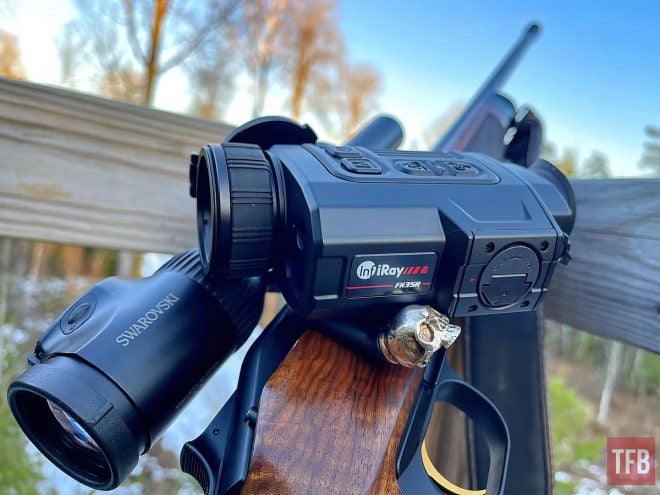This is a review of the InfiRay FH35R Thermal Monocular. These devices are typically used by hunters for scouting before and after the shot, but there are many other uses like finding missing persons. I really like this InfiRay. It has a good image quality, it’s easy to use and it’s relatively small and light. On top of that, there’s a Laser Range Finder (LRF) built-in, and while not cheap, the device is reasonably priced. It’s been my companion on several driven hunts, and I’ve used it to scout various areas to discover the performance and possible limitations.
InfiRay Outdoor @ TFB:
- Browning BAR Match & InfiRay Zoom ZH38 Thermal Imaging Monocular
- Friday Night Lights: PSQ-20 vs InfiRay JerryF – Fusion Monocular Duel
- iRayUSA – New Series of Thermal Imaging Monoculars
- iRayUSA New RICO MK1 W/ Laser Range Finder
Thermal imaging gives you the ability to detect heat both during day and night.
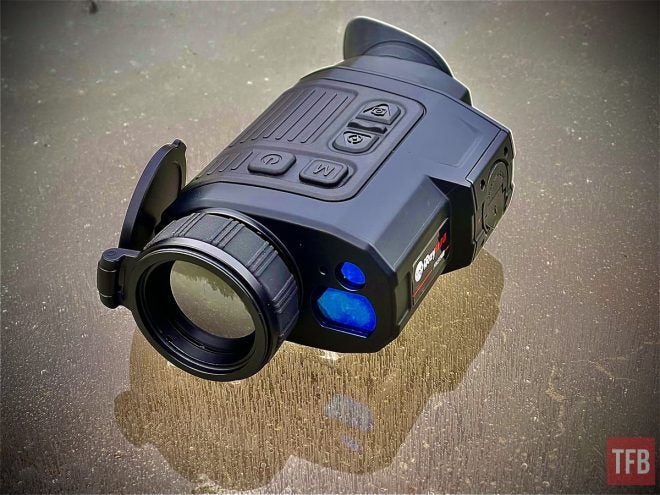
Below: The driven hunt. Blaser R8 in 300 WinMag and Swarovski Z6i and InfiRay FH35R Thermal Monocular. During moments of “silence” it’s pretty nice to have a thermal monocular to scout around and let time pass. A thermal is pretty good for safety as well, as you can see other non-targets like fellow hunters, dog handlers and their dogs in the forest so you know where not to point your rifle.
Below: Hunter at about 60 meters, with rifle on tripod. Winter, +2C, snow and ice on the ground and no direct sunlight.

A thermal monocular is a perfect companion for many reasons.

Overview
The heart of the InfiRay FH35R is a 12μm 640×512 pixel pitch high-resolution thermal sensor with a NETD of <35 mK. The lower the NETD the better, and it affects how clearly you can see objects and makes it easier to get the right focus among many other things. The objective lens is F35/1.0 and a frame rate is 40 Hz. The detection range is said to be 1818 meters. I did follow a helicopter for a very long distance, definitely much longer than 2 kilometers and it was still clearly visible. All this is displayed on an OLED with 1024×768 resolution.
Below: InfiRay Tube TD50L Digital Night Vision Riflescope (back) and the RH35R monocular.
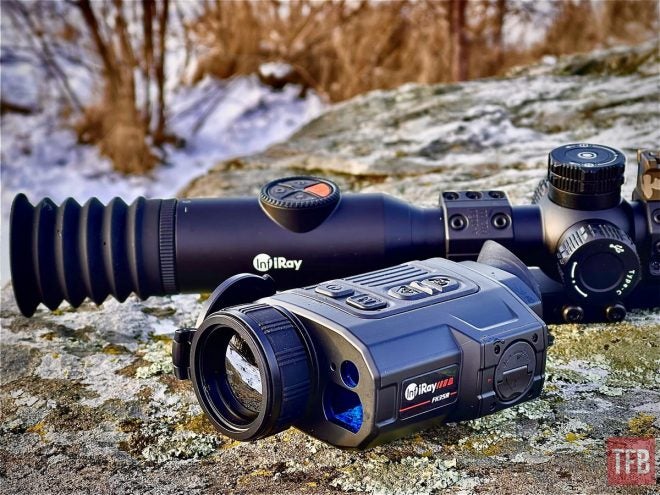
The battery life is reasonable, but it does like to suck those electrons out of the battery. I guesstimate you can run it for about 3-5 hours. Luckily you can replace the battery and continue using it. My unit came with a charger and two Li-ion batteries. Note that I used it during winter time only, which most likely reduces the battery time compared to summertime.
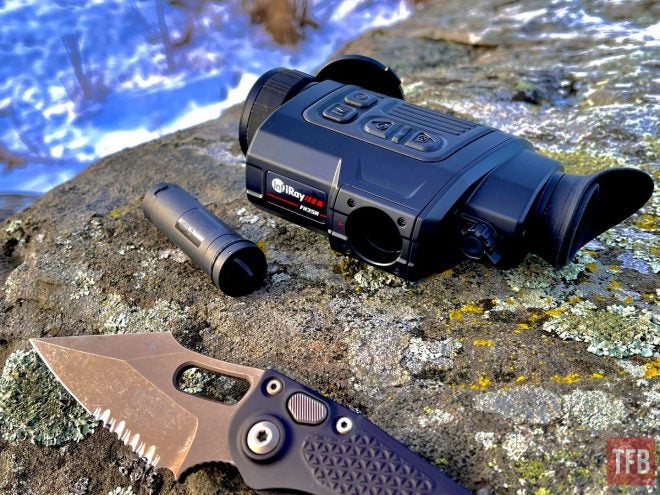
Overall, the build quality seems acceptable and it has IP67 protection for water and dust. The outer body is made of hard plastic, the buttons are rubberized, and you can operate it with gloves.

InfiRay Tube TD50L Digital Night Vision Riflescope with 940 IR Lamp (left) and the RH35R monocular.
Thermals On Ice
To give you an idea of the size and design here, it is side-by-side with the Pulsar Helion 2 XP50 Pro. The InfiRay FH35R is 160x90x50 mm and weighs about 400 grams. It fits the hand quite nicely and slips into the pocket without a problem.

The start-up time from pressing the start button until you have a thermal image is around 12 seconds. This is a fairly high number compared to some other units, especially if you’re impatient like me! It would be good if InfiRay could improve this on future models, but it’s not a major issue.
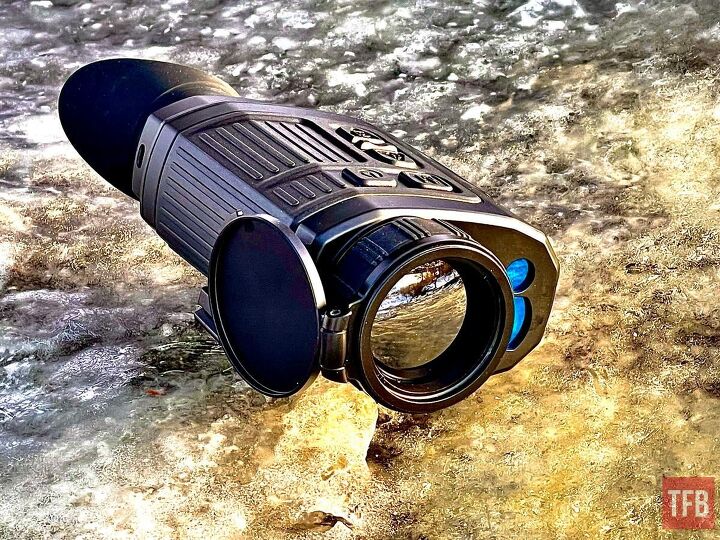
Setting the ocular is easy, and it’s done with the switch on the left side (not the battery cover). There’s also an infrared sensor switch that controls and switches the display on and off automatically to save power, and it works great. If the device is hanging in the straps, it’s off, if it detects your head, it turns on. Wonderful! It can be a little difficult to get 100% straight contact to the rubberized ocular, but most of the time you get an accetable image anyway.

Operating the InfiRay FH35R is fairly easy, but there’s some room for improvement. I’m not much for reading manuals until I get really stuck, and then they’re usually not much help anyway. The software menu inside can sometimes be a little bit difficult to understand, but trial and error helped me out.
Image Quality
If you haven’t looked into a modern high-end thermal, you should. The sensor has 640×512 pixels and it delivers a good quality image.
A lof of people say you can’t get a sense of depth in a thermal. I wonder if they’ve tried a modern one? Of course the picture is flatter than in a traditional optic, but to say that you don’t get a sense of depth is wrong – because you do! If it’s pitch black you can also use the focus wheel live to get an understanding which objects that are more distant than others.
Below: Walking couple at 35 meters. Chimney at almost 2000 meters. Note the smoke from the right chimney. There’s a Picture-In-Picture function if you like, but I find that more useful on riflescopes than spotters.

Another example with a lot of depth in it. Sign at 7 meters, car at 40 meters, fence to the left and houses further away in the back.

Sample Videos
Here are two roe deer in the winter. I am using the LRF (hence the reticle) but the on-screen display and the range is not displayed in the video. There is also a function with continuous ranging. The distance was around 15 – 45 meters. Winter, -4C and pitch black outside. Without the thermal it was impossible to see them, with the FH35R there’s no hiding.
Price
The price for the InfiRay FH35R (in Europe) seems to be around €2,900.00, but it can be found for less. Considering the “market” and the performance and features of the FH35R, I think it’s reasonably priced. Devices with LRF and 640 sensors don’t come cheap. The device is made in China and InfiRay seems to have a system with 1-2 distributors per country.

Daytime Winter, -2C, overlooking the lake, some sunlight and you can see the heat from windows. There are some people walking by the beach. This looks better in the camera than in a still image, but it’s not perfect. Red hot has its limits, and compare it to the white hot image below.

Using the 4x digital zoom doesn’t really help, you just get a more pixelated image.

Below you can compare white hot and red hot. There’s a person on the bridge, distance about 260 meters.

Or do you prefer red hot? I don’t on this machine.
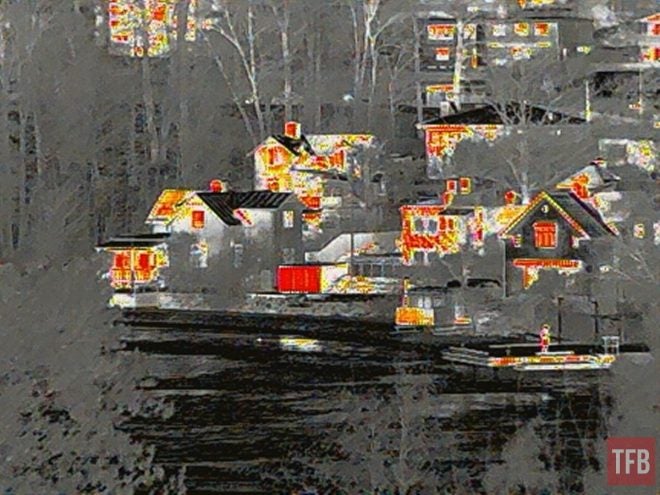
A person in a boat, 450 meters. It was hard to see anyone with the naked eye, but the InfiRay made it clear. There’s also some kind of animal (a dog?) on the island, to the mid-right.

You can see the houses 1900 meters away, and the line in the center of the image where there is ice vs clear water.

450 meters to the concrete bridge in the center of the image. White hot. Note that during winter almost everything is the same temperature on a cloudy day like this, so the image quality may improve radically if there is heat from the sun warming up objects.

Below: A bunch of thermals and night vision devices gathered. The FH35R has built-in accelerometer and a digital compass if you want to display that information on the HUD.

The Finder II Series come with 32GB of digital storage for videos and photos, plenty enough. You can transfer videos and photos to a computer through cable or using WiFi to your mobile device. You can record audio if you like. There’s an ARCA adapter to be able to mount it on a tripod attached here (my personal one).

On/Off, Menu, arrow up/down works for LRF and Camera/Video. To record a video, long press the camera icon and it starts recording with a short delay. It’s not as tactile as I would like, but not as bad as the InfiRay Zoom ZH38.
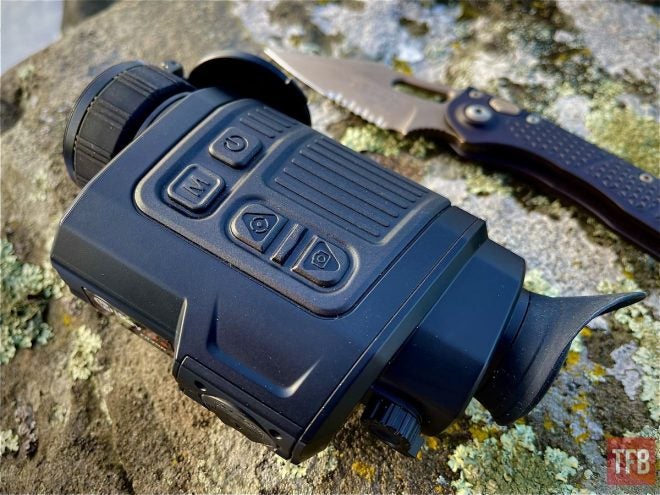
FH35R and the Delta Optical Stryker HD 1-6×24 mm LPVO behind.

Below: Another model from InfiRay TFB is about to review: The ZH38 Zoom, with a Dual Field of View design and shutterless technology.

Various thoughts
It could be that I’m not used enough to InfiRay’s terminology and products yet, but I find that the product name “FH35R” doesn’t really tell me much about what to expect, and it’s difficult to remember. The objective lens is 35 mm, fair enough, but why not mention the LRF in the product name? The series is called “Finder”, but it’s nowhere to be found (no pun intended) on the product.
“Just be stable, just be clear” – that’s the slogan that appears on the screen when I power on the device. It doesn’t really make any sense to me. Perhaps it’s some Chinese proverb? What happens if I’m not stable? Is the device not as clear then? Do you know? Let us know in the comments please.
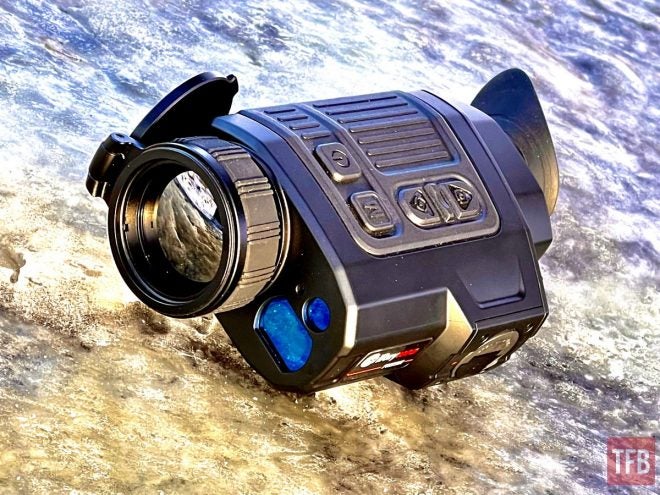
Conclusion
I enjoyed using the InfiRay FH35R and was impressed by the ergonomics, size and image quality. They also managed to include a Laser Range Finder in the package, which is quite impressive and an appreciated function. However, there are some minor things that InfiRay could improve until next time. When scrolling around the menu, it’s not always clear which icon/function you’re about to chose, and what it does. A few of the color pallettes are a bit crazy in my opinion, but white hot worked very well and red hot was good on animals close by. I didn’t really have any issues with the unit at all. If you’re looking for a thermal monocular in this segment, you should check it out, preferrably with a dealer that lets you look at various devices side-by-side. The FH35R is now going back to InfiRay, but I would have liked to keep it and that’s a pretty good recommendation.
Here is a direct link to the FL35R (not tested) and the FH35R: Infiray Outdoor.
 Your Privacy Choices
Your Privacy Choices
